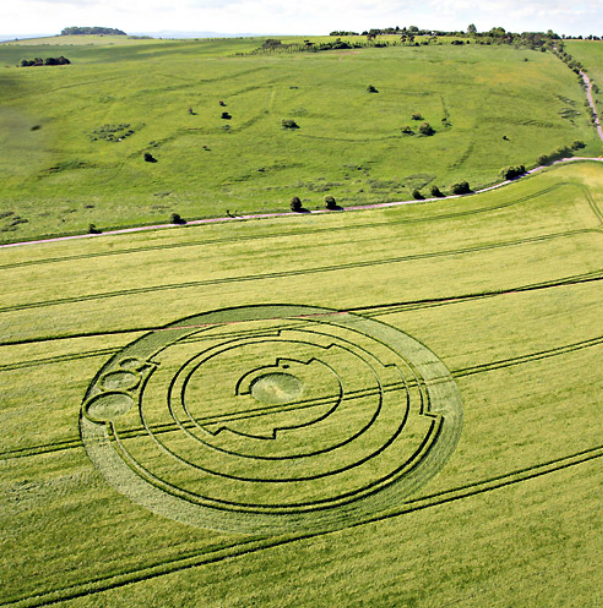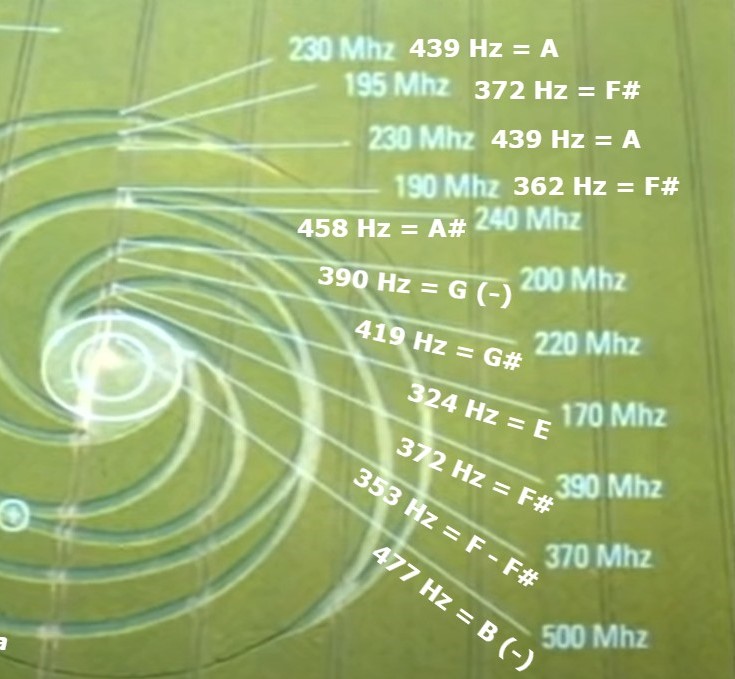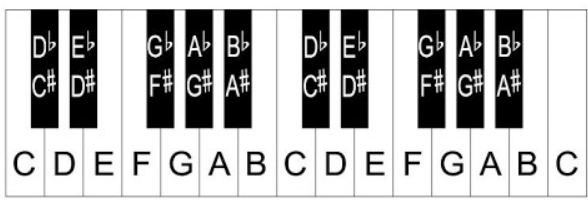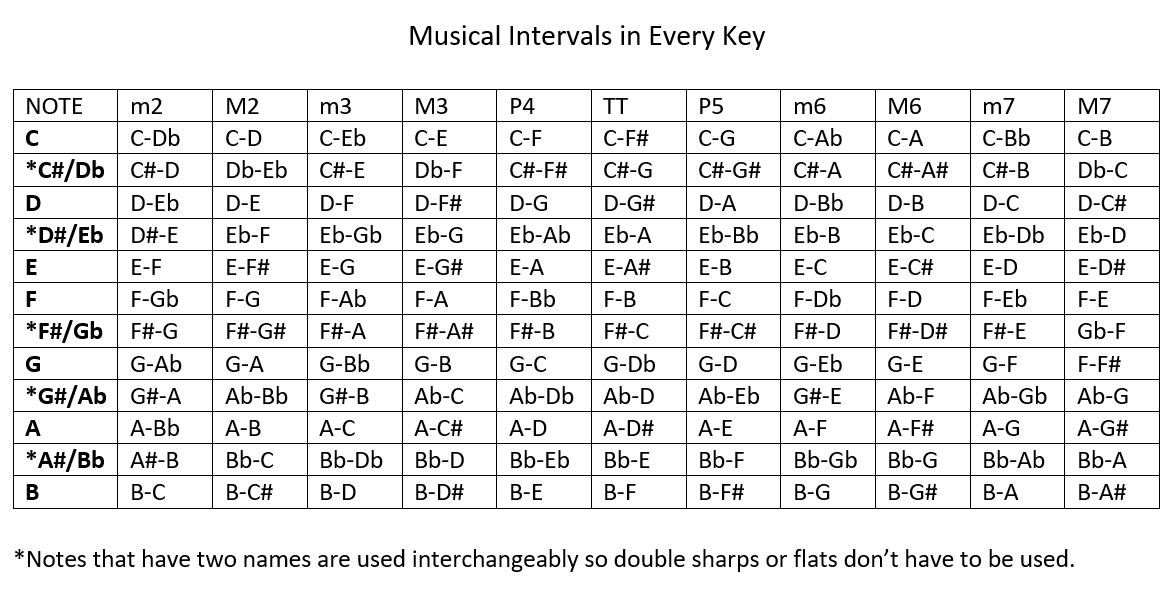In this article, we add another layer of "all things F#" and compare/contrast how the key of F-sharp is seen in crop circles and ancient sacred sites. Allow what I present here to send you on your own journey of discovery into the fascinating world of the frequencies within creation.
First, we quickly review what we've explored so far as we "stack" the information into one nice tight package of frequency goodness!
Recap Time!
Crop Circles

Figure 1 - Barbury Hill in the UK
For this article, we focus on sacred sites and crop circles. I've gathered enough information over the years that I can report the basics. It will take many more measurements along with reading additional materials to come up with greater solid evidence showing there is intelligent design in the creation of everything within the universe. Crop circles appear to carry a lot of information! Freddy Silva says that crop circles are really 3D but we see them as 2D.
Crop circles are formed by an electromagnetic field that comes from within the ground. At first, I believed the circles were formed by wind refraction but further reading led me to a better understanding of their creative process. The most thorough book on the subject is titled, Secrets in the Fields by Freddy Silva. Click on the title to purchase it on Amazon.
After reading Silva's book, I came up with some major points concerning crop circles. The entire book can be mostly nailed down to a few key factors that are listed below. Silva presents many stories that correlate to the various crop circle experiences. The best part about Silva's work is that he's been inside many crop circles and has first-hand knowledge of how they function.
In Secrets in the Fields, Silva presents credible evidence that crop circles aren't random occurrences. Figure 2 is in Silva's book but he created another version of it for a YouTube presentation where he adds the MHz frequencies of each arch. I took his measurements, brought them down several octaves, and found the corresponding Hz frequency (musical note).
Notice in Figure 2 how the musical notes represented by the Hz frequencies fall within either the F# Major or f# minor scale? The minus sign (-) next to a note name indicates it's quite flat in pitch. We'll break down the musical intervals and ratios of this crop circle further down in this article.

Figure 2
On the website, HyperPhysics, is a chart of the most harmonious intervals in music. They are the common intervals represented in nature, in the cosmos, and within sacred geometry. These ratios not only represent a musical frequency but a "distance ratio" as well. Therefore, when seeing that an octave represents a 2:1 ratio, think of that as the space between two objects as well.
Here are the most harmonious ratios in music that we also find in nature:
- Perfect Octave - 2:1
- Perfect 5th - 3:2
- Perfect 4th - 4:3
- Major 3rd - 5:4
- minor 3rd - 6:5
The above common intervals are present within the first 6 partials of the musical harmonic series. They are the strongest (most prominent) intervals heard in every sound of the main note/frequency (partial 1). As a reminder, certain intervals are called "perfect" because they're the most pure tones. These musical ratios appear to closely match "just intonation" temperament. It's a natural "tempering" of the distance between notes so the ratios are whole numbers that don't include fractions. Amazingly, not only do they create whole numbers but when playing or singing these ratios, they're in tune!
The website, Audio Labs, lists all intervals and their ratios. Hyper Physics only listed the most common ratios. Here are the remaining ratios...
- Major 2nd - 8:9
- minor 2nd - 15:16
- Major 6th - 3:5
- minor 6th - 5:8
- Major 7th - 8:15
- minor 7th - 5:9
- Tri-tone (Augmented 4th or diminished 5th) - 32:45
NOTE: When adjusting the distance between two notes (an interval), it's "tempering" the tuning by making one note higher or lower from the other note. Just Intonation is the most natural form of adjusting interval distances that we see in musical tuning. By using the ratios listed above, when reading Silva's book or hearing anyone else discuss ratios in the cosmos, nature, within crop circles or sacred sites, these are the ratios they appear to refer to. Why is that? Because nature knows what's natural.
REMEMBER - ratios also represent musical intervals. Therefore, when seeing ratios within crop circles and sacred geometry, find the musical interval that represents a specific ratio. For example, a 2:1 ratio is a Perfect Octave. A 3:5 ratio is a Major 6th. A 4:3 ratio is a Perfect 4th. A 6:5 ratio is a minor 3rd. Make sense?
Charts and more charts!
For your viewing pleasure, I've included a full chart of musical intervals in Figure 4. Notice that some notes have two names. These notes are called "enharmonics" because they have the same sound but are written differently (A# is also a Bb and G# is also an Ab as examples).
See Figure 3 for a picture of the piano keyboard that shows that the black keys have dual names. Yes, some of the white keys also have dual names, too. We see this occurring in the key of F# major. In the key of F#, F is called E# because it's the proper "spelling" of the 7th note in the key of F#. Why is it written this way? Because in music, we spell scales a specific way to represent "scale context" just like in English, we spell words differently that sound the same depending on their context (to, too, and two as an example). The key of F# doesn't have both an F and an F#. There HAS to be some version of an E instead of two types of the note, F. In order to create an F# major scale, we raise the 7th note, E, up a half a step and call it E# which completes the formula used in building a major scale. Therefore, E# is the "official" note name used as the 7th note in F# Major. In a nutshell, the note F is in the F# major scale. We simply call it E# for musical accuracy. Clear as mud?
Look for these scales on the keyboard in Figure 3.
- F# Major scale (6 sharps in key signature): F#, G#, A#, B, C#, D#, E#, F#
- F# "natural" minor scale (3 sharps in key signature): F#, G#, A, B, C#, D, E, F#
- F# pentatonic scale (all the black keys on the piano): F#, G#, A#, C#, D#, F#

Figure 3
In some situations (mostly the sharp/flat keys), the chart in Figure 4 shows some alternate note names (C# instead Db as an example) so the intervals are written correctly. For example, the distance from A - C is separated by three notes so it's the interval of a 3rd. A - C# is also a third. A - D is a 4th because they are four notes away from each other. A - E is the interval of a 5th. The details of Perfect, Major, Augmented, diminished, and minor qualities of the various intervals are not addressed in this article. That's geeky music major stuff that would probably bore many of those reading this. If you really want to understand interval qualities, there are great YouTube videos that explain musical intervals. Moving along...
Translation of terms in Figure 4:
- small "m" = minor interval
- Capital "M" = Major interval
- TT = tri-tone which is an A4 (Augmented 4th) or d5 (diminished 5th)
- P = Perfect interval
- The number next to each letter in the top row refers to the interval type (2nd, 3rd, 4th, 5th, etc.).
- A letter next to the number in the top row refers to the interval quality (Major, minor, Perfect).

Figure 4
As I digested Silva's book, there is musical information presented that needs further explanation. When reading musical details, one researcher that Silva quotes says the ratios are limited to the 7 main notes of the scale (A, B, C, D, E, F, and G). However, that's not accurate because every ratio can be created with all 12 notes. Figure 3 demonstrates the placement of all 12 notes on a piano keyboard and Figure 4 shows all twelve versions for every interval. That translates to 12 note combinations for every ratio/interval.
Let's explore how this works... a Perfect 5th (P5) can be created from every note on the piano. There are 12 note combinations that create the interval of a Perfect 5th... the ratio of 3:2. The twelve Perfect 5ths starting from C and going up the scale chromatically are: 1) C - G, 2) C# - G#, 3) D - A, 4) Eb - Bb, 5) E - B, 6) F - C, 7) F# - C#, 8) G - D, 9) Ab - Eb, 10) A - E, 11) Bb - F, 12) B - E and then you're back at C where you start at the very beginning. Sing along now! (Refer to the P5 column in Figure 4.)
Here's some further food for thought.... How do we know that our current note name of F# wasn't called by another name in ancient times? We've only had the ability to exactly measure a musical frequency since the middle of the 1800's A.D. So, there's no way we can say only the white keys on a piano create ratios. In reality, a musical ratio determines a distance between two notes which we call a musical interval. The only way to know the exact note name is to take an accurate measurement of a pitch that's heard, which doesn't appear to have been possible in ancient times. With crop circles and sacred sites, it IS possible to determine musical ratios but not know exact pitches. To me, this demonstrates the importance of musical intervals in ancient sites, crop circles, nature, the cosmos, the beginning of time, and possibly for healing and wholeness purposes.
In Silva's book, he discusses what I call "distance ratios" within crop circles. Plainly stated, a distance ratio is a measurement from one energetic point in a crop circle to another energetic point. They're presented as ratios throughout Silva's book. Musically, we can turn the distance ratios into musical ratios. The exact musical pitches aren't known unless someone recorded the sounds coming from a crop circle. However, few researchers have disclosed specific pitches emitted from crop circles. If some have figured out specific pitches, not many researchers have made that information public. But... not all is lost! When distance ratios in crop circles are provided, it's easy to determine which musical intervals are most prominent in a particular crop circle by translating distance ratios into musical ratios which then tells us the musical intervals of a crop circle.
What does all this mean? More research is needed to make further determinations. I suspect that musical ratios (intervals) play a huge part in a creative and/or healing process. I provide an example in the first section of this article where Royal Raymond Rife used two musical notes (a musical interval which is also a ratio) to work with cancer patients. I am beginning to pay closer attention to the musical intervals I use when creating sound baths for people. It's only a matter of time before a clearer picture emerges. When that occurs, you'll see a new article!
Crop circle examination time!
Let's revisit Figure 2 (posted again below to keep you from scrolling up) by translating the musical pitches into ratios starting from the arch that's on the outside of the crop circle and then moving inward to the center arch. Here are those musical frequencies translated into musical ratios (musical intervals).
- Arch 1 to Arch 2 is an A DOWN to an F# which is the descending musical interval of a minor 3rd, or a 6:5 ratio.
- Arch 2 to Arch 3 is an F# UP to an A which is the ascending musical interval of a minor 3rd, or a 6:5 ratio.
- Arch 3 to Arch 4 is an A DOWN to an F# which is the descending musical interval of a minor 3rd, or a 6:5 ratio.
- Arch 4 to Arch 5 is an F# UP to an A# which is the ascending musical interval of a Major 3rd, or a 5:4 ratio.
- Arch 5 to Arch 6 is an A# DOWN to a G which is the descending musical interval of a minor 3rd, or a 6:5 ratio. NOTE: A# is also Bb and Bb to the lower G is a minor 3rd.
- Arch 6 to Arch 7 is a G UP to a G# which is the ascending musical interval of a minor 2nd, or an 8:9 ratio.
- Arch 7 to Arch 8 is a G# DOWN to an E which is the descending musical interval of a Major 3rd, or a 5:4 ratio.
- Arch 8 to Arch 9 is an E UP to an F# which is the ascending musical interval of a Major 2nd, or an 8:9 ratio.
- Arch 9 to Arch 10 is an F# to the same F# but a slightly lower pitch. It's considered nearly a Perfect Unison, or a ratio of 1:1
- Arch 10 to Arch 11 is an F# UP to a B which is the ascending musical interval of a Perfect 4th, or a 4:3 ratio.
See Figure 5 for a visual of what these musical ratios look like on a page of sheet music as they ascend and descend according to the specific MHz - Hz frequency Silva provides in Figure 1.

Figure 5
What can we learn from these musical frequencies and intervals within this particular crop circle? First, all but one note (G) fits within an F# Major or f# minor scale. The note, G, can be considered "borrowed" from another key. The fact that 5 other notes are on either side of the G is interesting. The G note is the middle arch in this crop circle. Hmmmmm.....
F# is the main note representing the sound at the beginning of time, is also the key signature, and is repeated four times. Next, the most prominent interval is a minor 3rd (6:5 ratio). I find that interesting, especially since the minor 3rd represents the voice of Yahweh. The next most prominent interval in this crop circle is a Major 3rd (5:4 ratio), which represents the voice of Yeshua. (See article 2 in this series for more information about the musical frequencies of Hebrew letters.)
Question? What do you suppose this crop circle represents?

Sacred Sites
Most of the acoustical information from sacred sites is minimal only because researchers haven't considered the musical component until recently. The new science of archaeoacoustics brings multiple disciplines together to study ancient sacred sites. A group of researchers gathered for their first conference in Malta, Italy in 2014. Researchers, including acoustical specialists, who had visited sacred sites presented their findings at that first conference. I believe there's been a couple other conferences since 2014.
Archaeoacoustics is "acoustic archeology." Basically, it involves measuring sound and reverberation times within a monument or sacred site. That information is then compared with what archeologists, geologists, anthropologists, Egyptologists, archaeoastronomers, and other researchers find concerning sacred sites. When combining all the information, there's a stronger sense of what a site was used for.
Researchers are discovering that many ancient sites weren't tombs (Such as the Giza Pyramid) or temples. They were used as acoustical devices during ceremonies to bring people into altered states so they could step into a mystical experience that made them feel closer to their gods. A point to ponder.... Is it possible the ancients thought angelic beings were "gods?" Their practice of connecting with the spiritual world often involved the use of brain altering plants that brought about a state of higher consciousness more quickly. In some cases, sacred sites doubled as cemeteries - such as the Hal Seflieni Hypogeum in Malta.
Below, I've listed what I have so far concerning measurements from the sites where archaeoacoustics teams have taken measurements. As you look over the frequencies, check the F# Major and minor scales above to see which scale may be represented by that site. At every site I've found so far, the resonant frequencies fit within either the F# Major or f# minor scales. Coincidence?
Conclusion
Although much of archaeoacoustic research is in its infancy, measurements are beginning to come in that lead one to realize there's specific resonant frequencies within and around megalithic monuments, ancient sites, and crop circles that harmonize with one another and the entire universe. Is this a coincidence? Or, does everything in nature naturally find a harmonious resonance that came from the beginning of time we're still "tuning to."
Modern society has come to know technology in a different manner than the ancients. It appears the ancients could "read" the stars and understand the changing of the seasons (winter and summer solstice, spring and fall equinox, etc.) through the use of ancient sites whereas we rely upon the media for reports. The ancients understood more about how creation works than our current society. It seems they were quite accurate with predictions as well as understanding the "times and seasons." Yeah, we have the Farmer's Almanac but it seems the ancients had a better method.
There's a new science (archaeoastronomy) that can date megalithic monuments by their position to the constellations at the time they were created. For example, some date the Great Sphynx on the Giza Plateau to be much earlier when it's eyes actually faced the constellation, Leo. Water erosion on the sphynx is another indicator that it's much older than claimed by Egyptologists. The sphynx is an example of how the ancients created monuments for reasons that aren't yet understood by modern society. Is that because we don't know how to "read" nature and the cosmos like the ancients?
It seems that if we go back to our roots at the beginning of time to understand how we fit into the fabric of creation, we may find the path to live as we were originally created to function. That includes understanding how our entire being resonates, entraining and entangling with everything in creation. It's possible that we can live a life of greater wholeness if we consider our entire being - spirit, soul, and body as equal in importance. We learn to function not only with the mind (the intellect) but with our soul and spirit as well. To become a complete being (our spirit, soul, and body all functioning in harmony as one unit), we come into alignment with our true nature. In order to do that, it seems we must work in harmony with nature, each other, and our Divine Creator. What I do know is that we must resonate with the frequency of unconditional and perfect love in order to function according to our original design.
For now, this is the end of the series. Although I have much more to share, that information will have to wait until I've put more puzzle pieces in the right places. If you find articles that might interest me, please use the Contact Us page to submit the information!
Now, it's time to go practice some F# scales.
Del Hungerford, December 2022
NOTE: None of the information in this series or any other article on this site may be used without permission! You may share the articles but if you wish to quote my work in your own writing, it is "good form" to cite any materials that aren't your own.
Sources
- Secrets in the Fields by Freddy Silva
- Musical Frequencies of the Hebrew Letters by Del Hungerford
- YouTube presentation by Freddy Silva on crop circles
- Hyper Physics article on musical ratios
- Audio Labs article on musical ratios
- Frequencies of Creation: Part 1 by Del Hungerford
- Frequencies of Creation: Part 2 by Del Hungerford
- Frequencies of Creation: Part 3 by Del Hungerford
- Frequencies of Creation: Part 4 by Del Hungerford
- Frequencies of Creation: Part 6 by Del Hungerford
- Frequencies of Creation: Part 7 by Del Hungerford

